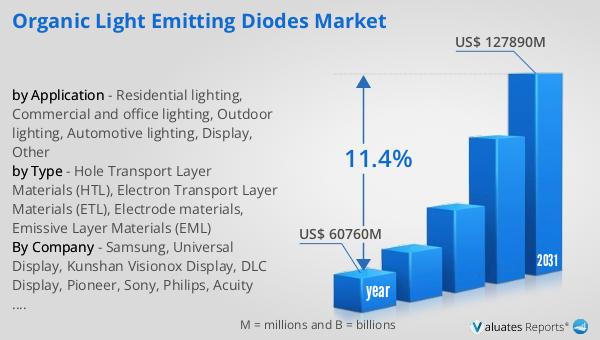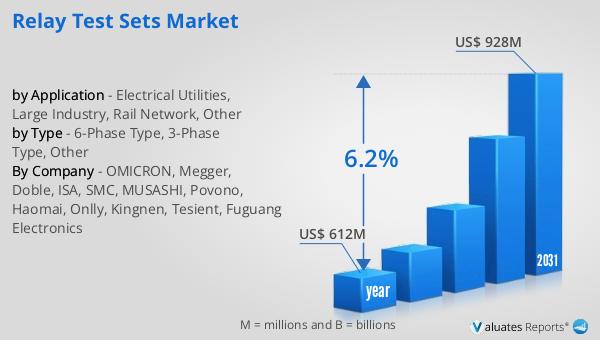What is Global Organic Light Emitting Diodes Market?
The Global Organic Light Emitting Diodes (OLED) Market is a rapidly evolving sector within the broader display and lighting industry. OLEDs are a type of display technology that uses organic compounds to emit light when an electric current is applied. Unlike traditional LED displays, OLEDs do not require a backlight, allowing for thinner, more flexible, and more energy-efficient screens. This technology is increasingly being adopted in various applications, from smartphones and televisions to lighting solutions, due to its superior image quality, vibrant colors, and the ability to produce deep blacks. The market is driven by the growing demand for advanced display technologies and energy-efficient lighting solutions. Additionally, the increasing consumer preference for high-quality display panels in electronic devices is propelling the market forward. As manufacturers continue to innovate and improve OLED technology, the market is expected to expand further, offering new opportunities for growth and development in the coming years. The versatility and efficiency of OLEDs make them a compelling choice for both consumers and manufacturers, positioning the market for continued success.

Hole Transport Layer Materials (HTL), Electron Transport Layer Materials (ETL), Electrode materials, Emissive Layer Materials (EML) in the Global Organic Light Emitting Diodes Market:
In the realm of OLED technology, several key materials play crucial roles in the functionality and efficiency of the devices. The Hole Transport Layer (HTL) materials are essential components that facilitate the movement of positive charge carriers, or holes, from the anode to the emissive layer. These materials are crucial for ensuring efficient charge injection and transport, which directly impacts the brightness and efficiency of the OLED. HTL materials are typically organic compounds that possess high thermal stability and excellent film-forming properties, allowing for the creation of uniform and stable layers. On the other hand, Electron Transport Layer (ETL) materials are responsible for transporting electrons from the cathode to the emissive layer. These materials are designed to have high electron mobility and low electron injection barriers, ensuring efficient electron transport and recombination with holes in the emissive layer. ETL materials are often composed of organic molecules or metal oxides, chosen for their ability to enhance the overall performance of the OLED device. Electrode materials, including anodes and cathodes, are critical for injecting charges into the OLED structure. The anode is typically made of transparent conductive materials like indium tin oxide (ITO), which allows light to pass through while conducting electricity. The cathode, usually composed of metals like aluminum or silver, is responsible for injecting electrons into the ETL. The choice of electrode materials significantly influences the device's efficiency, stability, and overall performance. Emissive Layer Materials (EML) are at the heart of OLED technology, as they are responsible for light emission. These materials are organic compounds that emit light when electrons and holes recombine within the layer. The color and efficiency of the emitted light depend on the specific EML materials used, which can be tailored to produce a wide range of colors. The development of new EML materials is a key area of research, as it directly impacts the color gamut, brightness, and energy efficiency of OLED displays. Together, these materials form the backbone of OLED technology, each playing a vital role in the device's operation and performance. The ongoing research and development in HTL, ETL, electrode, and EML materials continue to drive advancements in OLED technology, paving the way for more efficient, durable, and versatile OLED applications.
Residential lighting, Commercial and office lighting, Outdoor lighting, Automotive lighting, Display, Other in the Global Organic Light Emitting Diodes Market:
The Global Organic Light Emitting Diodes Market finds extensive usage across various sectors, each benefiting from the unique advantages offered by OLED technology. In residential lighting, OLEDs are increasingly being adopted due to their energy efficiency, flexibility, and ability to produce high-quality light. Homeowners appreciate the sleek design and the ability to create ambient lighting effects, making OLEDs a popular choice for modern home interiors. In commercial and office lighting, OLEDs offer significant energy savings and reduced maintenance costs, making them an attractive option for businesses looking to improve their sustainability credentials. The ability to produce uniform, glare-free light is particularly beneficial in office environments, where lighting quality can impact employee productivity and well-being. Outdoor lighting is another area where OLEDs are making inroads, thanks to their durability and ability to operate efficiently in various weather conditions. The use of OLEDs in streetlights, signage, and architectural lighting is growing, driven by the need for energy-efficient and environmentally friendly lighting solutions. In the automotive industry, OLEDs are being used in both interior and exterior lighting applications. Their flexibility and thin profile allow for innovative design possibilities, while their high brightness and color accuracy enhance visibility and safety. OLED displays are also becoming more common in vehicle dashboards and infotainment systems, offering drivers and passengers a superior visual experience. In the display sector, OLEDs are revolutionizing the way we interact with electronic devices. From smartphones and tablets to televisions and wearable devices, OLED displays offer unparalleled image quality, vibrant colors, and deep blacks. The ability to create flexible and foldable displays is opening up new possibilities for device design and functionality. Beyond these applications, OLED technology is also being explored in areas such as medical devices, where its biocompatibility and ability to produce high-quality light are advantageous. As the technology continues to evolve, the potential applications for OLEDs are expanding, offering new opportunities for innovation and growth across various industries.
Global Organic Light Emitting Diodes Market Outlook:
The global market for Organic Light Emitting Diodes was valued at approximately $60,760 million in 2024 and is anticipated to grow significantly over the coming years. By 2031, the market is projected to reach a revised size of around $127,890 million, reflecting a robust compound annual growth rate (CAGR) of 11.4% during the forecast period. This impressive growth trajectory underscores the increasing adoption and demand for OLED technology across various sectors. The market's expansion is driven by the continuous advancements in OLED technology, which enhance the performance, efficiency, and versatility of OLED applications. As more industries recognize the benefits of OLEDs, such as their energy efficiency, superior image quality, and design flexibility, the demand for these products is expected to rise. The growing consumer preference for high-quality display panels in electronic devices, coupled with the need for energy-efficient lighting solutions, is further propelling the market forward. As manufacturers continue to innovate and improve OLED technology, the market is poised for continued growth and development, offering new opportunities for businesses and consumers alike. The future of the OLED market looks promising, with significant potential for expansion and innovation in the years to come.
| Report Metric | Details |
| Report Name | Organic Light Emitting Diodes Market |
| Accounted market size in year | US$ 60760 million |
| Forecasted market size in 2031 | US$ 127890 million |
| CAGR | 11.4% |
| Base Year | year |
| Forecasted years | 2025 - 2031 |
| by Type |
|
| by Application |
|
| Production by Region |
|
| Consumption by Region |
|
| By Company | Samsung, Universal Display, Kunshan Visionox Display, DLC Display, Pioneer, Sony, Philips, Acuity Brands, Seiko Epson, Innolux, OLEDWorks, LG, OSRAM, RITEK |
| Forecast units | USD million in value |
| Report coverage | Revenue and volume forecast, company share, competitive landscape, growth factors and trends |
